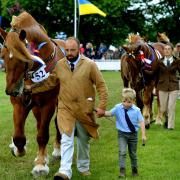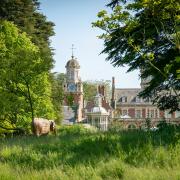We are very lucky in Suffolk to be one of the best places in the whole of the UK to see barn owls. And if you do see one of these beautiful birds, you tend to remember it for a long time.
I've been fortunate to see many barn owls and every time I see them it's always exciting. Suffolk has the perfect habitat for these owls, mainly due to the amount of farmland we have and the mixed types of land available to them.
I've also seen a pleasing increase in farmers welcoming barn owls, especially by erecting nest boxes in farm buildings. They used to nest in derelict farm buildings, but most of these either get knocked down or refurbished, so barn owls struggle to find nesting areas. I've also seen some using holes in trees to roost and nest.

You can tell male and female barn owls apart mainly by size – the female is larger – but colouration is also different. The male is much whiter, while the female has darker colours on her back and small black specks on her underwing and breast.
Barn owls' diet consists mainly of small rodents such as small rats, shrew, mice (wood, house mouse and harvest) and voles (water, bank and field). They may also take small birds if the supply of rodents is low, and I've even seen a male attempt to predate a stoat. They commonly stash food away to prevent their meals being stolen by other predators; kestrels will often attack and harass barn owls for their prey.
In winter barn owls find it tough to survive and are more susceptible to starving from lack of food. The vast majority of rodents that make up most of their diet are either hibernating or keeping warm somewhere. The weather can also be harmful, rain in particular. A barn owl's feathers are not waterproof as it can hamper their ability to fly silently when hunting for rodents.

One sure sign you’re at a location where there's a barn owl about is pellets on the ground, usually inside barns or farm buildings. These little balls are the indigestible parts of the barn owl's prey, such as bones and fur. It's interesting to collect pellets, take them home and submerge them in warm water. As the fur parts, revealing the skeleton remains of rodents, you can see what the owl has been feasting on.
The Barn Owl Trust website gives you some great information on how to identify the skulls of these rodents. It's a fun activity for children and adults; of course, I advise you to wear gloves and wash your hands thoroughly afterwards.

Photographing and watching barn owls
Barn owls are my personal favourite bird to photograph – they're always popular with wildlife photographers – but it's important to remember they are a Schedule 1 bird under the Wildlife and Countryside Act, which means it is a serious offence to disturb them at a nest site. The best and safest place to photograph or watch them is on their hunting ground.
It's also hugely important that don't disturb the bird while it's hunting as you may divert it from the task of feeding itself or its young, with serious implications for the survival of both. The best way to observe barn owls, with minimal stress and disturbance, is to find yourself some cover such as a hedgerow, bush or tree. Use these natural features to hide your body shape. The bird will be used to seeing these objects every time it hunts.

If you're really lucky you may have a relaxed barn owl that isn't bothered by you even out in the open. I've often had close encounters with barn owls when standing in clear view and they've caught me by surprise. If you don’t make any sudden movements, the owl may realise you’re not a threat and continue with the business of hunting unconcerned.
Technical stuff

Camera settings are quite difficult with barn owls; they normally make an appearance late in the day when the light is quite low. The best time to see them in daylight is when they have young; most of the time they will be trying to feed them as much as possible. Another good time is after a prolonged spell of rain. Barn owls can't hunt efficiently in rain, so they will be out looking for prey, perhaps even in perfect light.
The difficult part can be exposing the photograph correctly. Because barn owls are white, the camera struggles to collect a fast enough shutter speed to get a clear and well exposed image. The best thing to do is to set the shutter speed as high as possible, depending on the light available.
Set the ISO to match the lighting. The higher the ISO, the lighter the photo. More 'noise' will be added to the image, but some cameras, especially recently released models, handle noise very well, and new photo editing software makes it less of a worry.
So, start by setting your shutter speed anywhere between 1/320 - 1/1000 of a second, or higher, to freeze the action. The higher the shutter speed, the clearer the image. This will, in turn, make darker photos because a fast shutter speed exposes the sensor of your camera for a much shorter time. This may not be ideal for dusk, so keep an eye on the lighting conditions. This also helps to stop the bird’s white feathers ‘burning out’. This is when an object is over exposed and turns solid white; a barn owl would appear solid white with no visible feather detail.
Barn owls, like many birds, want to be as far away from you as possible as they regard you as a potential predator. So, the ideal lens is anything from 200mm or more. The most important thing – as with all wildlife – is to respect the owls and not chase them around a field. This not only causes unnecessary stress, but may possibly prevent the owl from returning.
We all know the feeling of wanting to get just that bit closer. If you need to change your position, move slowly and try not to disturb the bird. Sometimes, if you wait, it will come to you in its own good time.



























